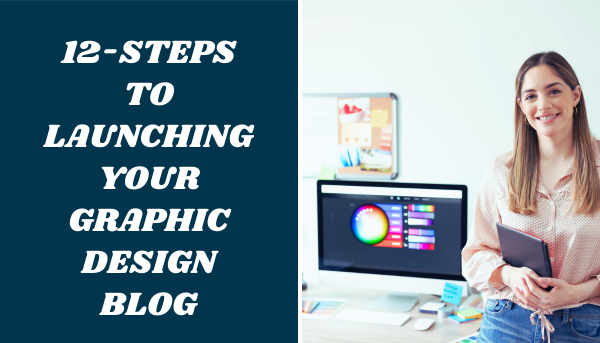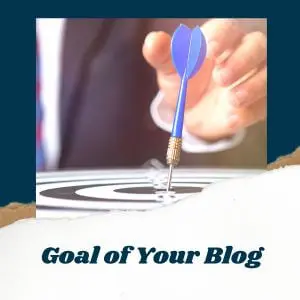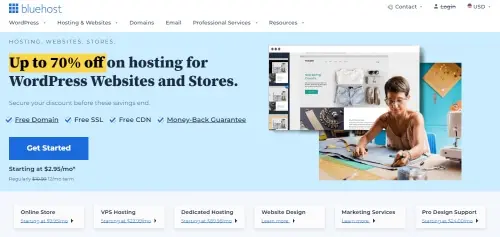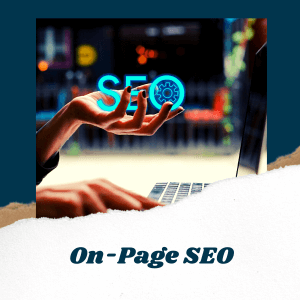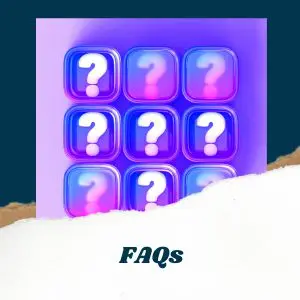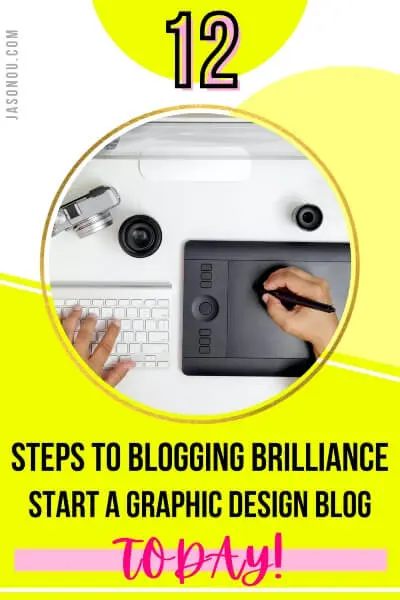How to Start a Graphic Design Blog – Ultimate Guide
Are you ready to dive into the exciting world of starting a graphic design blog? If you’re passionate about design and itching to share your creative journey with others, you’re in for an exhilarating ride.
In this extensive guide, I’ll personally walk you through the step-by-step process of how to start a graphic design blog, from choosing your niche and registering your domain name, to SEO optimization and monetization strategies for your blog.
Ready to build a thriving blog on Graphic design?
Key Takeouts
- Define your niche and identify your target audience to establish expertise and connect effectively with a specific group of readers.
- Register a domain name that is relevant to your graphic design niche and easy for your target audience to remember.
- Choose Bluehost for web hosting as it offers an intuitive platform, great designs, affordability, and reliable customer support.
- Promote your graphic design blog so it gets noticed and read by the right people.
How to Start a Graphic Design Blog in 12 Steps
This page have some affiliate links. In other words, if you buy from my links, I may get a commission. And some of the images were sources from Unsplash+.
- Define your niche and goals
- Register your domain name.
- Choose a web hosting provider. I recommend Bluehost.
- Use WordPress. It’s easy to use.
- Pick a WordPress theme to style up your graphic design website and blog.
- Install essential plugins to boost your blog’s performance.
- Create the main pages (About, Portfolio, Contact, Privacy Policy, etc).
- Do your keyword research.
- Publish your first blog post.
- Promote and share your blog.
- Make money blogging by selling products and services.
- Plan your content and blog regularly.
Ready to start your very own blog on graphic design? Read on.
How to Start a Blog on Graphic Design 2025
If you want to launch a successful graphic design blog, the first step is to determine your niche and pinpoint your target audience.
Step 1 – What’s Your Niche?
Venturing into the world of graphic design blogging is an exciting journey, one that begins with defining your niche.
It’s critical to carve out a specific niche or area of focus that both interests you and aligns with market demand.
The rationale behind honing in on a specific niche is twofold. It helps establish your expertise and credibility, and it enables you to connect more effectively with a targeted audience who are interested in the same subjects as you.
For instance, if you’re particularly adept at creating beautiful logos using innovative techniques and thinking, make this specialty your primary content focus point.
On the other hand, if web layout designs excite you more than anything else does, let that be what drives your blog content strategy forward.
Step 2 – Whose Your Audience?
Cracking the code for a successful graphic design blog starts with identifying your target audience.
Understanding who you’re creating your content for can help establish direction and focus on your blog.
Your target audience could be anyone from aspiring graphic designers seeking tips and tutorials, businesses in need of design services, or other creatives searching for inspiration.
To zero in on your ideal readership, consider demographics such as age, interests, occupation, and even challenges they might face related to graphic design.
Use online tools like Google Analytics or social media insights to gather data about people who interact with similar content online.
By following this step, you will establish a strong basis for producing top-notch work and attract the attention of individuals who appreciate the value of your offerings.
Step 3 – What is the blog’s purpose?
Before you go off fast and furious starting a graphic design blog, you have to determine your blog’s purpose.
This is because when you have a purpose, it will help set the tone for all the content you share with your readers.
With your graphic design blog, consider what you hope to achieve.
Is it showcasing your artwork, sharing tutorials and design tips, or perhaps discussing industry trends?
Identifying this will provide direction in shaping your message effectively.
The importance of clarifying the blog’s mission can’t be overstated.
A study found that 46.1% of web users rely significantly on design when assessing credibility.
Ensuring that your blog’s purpose aligns seamlessly with its overall look enhances not only its appeal but also bolsters its perceived reliability amongst the readership.
Step 4 – Registering A Domain Name
To start your graphic design blog, one essential step is registering your domain name. Your domain name is your website’s unique address on the internet, and it plays a crucial role in establishing your brand identity.
And when it comes to your domain name. Make it short. Make it relevant. Make it easy to say and spell.
(You can even use your name to create a personal brand.)
To register a domain name, you can consider using Namesilo, Namecheap, or even Bluehost (more on this soon).
Step 4 – Whose Your Host?
Web hosting is a service that allows you to make your graphic design website accessible on the internet.
When you create a website, it is made up of different files like text, images, and videos, and these files need to be stored somewhere.
As well, it provides a secure place to store these files so that people can access your website from anywhere in the world.
You need web hosting if you want to make your graphic design blog accessible on the internet. Without web hosting, your website would not be available to anyone outside of your local network.
Which leads me to this.
Why Choose Bluehost?
Bluehost is a top choice for web hosting, especially for beginners in the blogging world. With its user-friendly interface and design options, Bluehost makes it easy to set up and manage your blog.
Plus, it’s highly reliable and offers excellent customer support.
Here are 6 key reasons to start a graphic design blog with Bluehost.
- Bluehost is officially recommended by WordPress, which means it’s a trusted and reliable web hosting provider.
- Bluehost guarantees a 99.9% uptime rate. This means that your website will be up and running almost all the time, which is important for businesses that rely on their website for sales or leads, as even a few minutes of downtime can be costly.
- They have 24/7 customer support.
- Bluehost offers a 30-day money-back guarantee, so if you’re not satisfied with their service, you can get your money back.
- When you sign up for Bluehost (Choice Plus plan), you get a free domain name and a free SSL.
- Bluehost offers 1-click WordPress installation, which means you can easily set up your website without any technical knowledge.
One more thing. Bluehost’s cheapest plans are its shared hosting plans, which range from $2.95 to $13.95 per month. Perfect for graphic designers who are strapped for cash.
| Plan | Pricing | Hosting Features |
|---|---|---|
| BASIC | $2.95/mo* (Save 40%) | 10 GB SSD Storage, 1 Website, Free Domain 1st Year, Custom WP Themes |
| CHOICE PLUS | $5.45/mo* (Save 50%) | 40 GB SSD Storage, Free CDN, Unlimited Websites, Free Domain 1st Year, Custom WP Themes |
| ONLINE STORE | $9.95/mo* (Save 35%) | 100 GB SSD Storage, Free CDN, Unlimited Websites, Free Domain 1st Year, Custom WP Themes, Exclusive Store Theme, Store Analytics |
| PRO | $13.95/mo* (Save 20%) | 100 GB SSD Storage, Free CDN, Unlimited Websites, Free Domain 1st Year, Free Dedicated IP, Custom WP Themes |
Table A – A brief overview of the cost & features for starting a blog on Graphic Design with Bluehost (12-month plan). For more details, check out the Bluehost pricing card here.
Don’t Miss This:
Before I get onto Step 5, here’s a snaphsot on how to start a WordPress blog on graphic design and in 7-steps.
How to Start a Graphic Design Blog With Bluehost
Setting up a blog with Bluehost is a simple process. Here’s how you can get started:
- Choose your hosting plan: Bluehost offers different hosting plans to cater to various needs. Whether you’re just starting out or expecting high traffic, there’s a plan for you.
- Register your domain name: Bluehost provides a free domain name for the first year with their hosting plans. Choose a domain name that represents your graphic design blog and check its availability.
- Set up your WordPress site: Bluehost offers one-click WordPress installation, making it quick and easy to set up your blog. Simply follow the prompts and provide the necessary details to launch your site.
- Customize your blog: Once your WordPress site is set up, it’s time to customize it according to your branding and preferences. Choose a WordPress theme that suits the visual style of your graphic design blog.
- Personalize the design elements: You’re a graphic designer so I won’t get into this too deep. But be sure to customize your website’s colors, logo, fonts, images, and graphics to create a cohesive and visually appealing look.
- Install essential plugins: Plugins add functionality to your blog, helping you enhance its performance and user experience. Install essential plugins like All in One SEO for search engine optimization, UpDraftPlus and WpRocket.
- Create the main pages: Set up essential pages such as About Me, Services, Portfolio, Contact Me, or any other pages relevant to your graphic design blog. These pages will help visitors navigate through your content easily.
With that said, let’s look at the above points in more detail next.
If you want a complete guide on how to start a graphic design blog with Bluehost, then check out this post 👇below👇.
An Ultimate Step-By-Step Guide to Starting a Bluehost WordPress Blog.
Step 5 – Customizing Your Blog
In this section, you’ll learn how to make your blog stand out with a custom design. Choose the perfect WordPress theme, and customize colors, logos, fonts, and graphics to create a visually appealing website that reflects your unique brand.
Don’t forget to install essential plugins and create main pages for easy navigation.
Ready to take your graphic design blog to the next level? Keep reading!
In this section, you’ll learn how to make your blog stand out with a custom design. Choose the perfect WordPress theme, and customize colors, logos, fonts, and graphics to create a visually appealing website that reflects your unique brand.
Don’t forget to install essential plugins and create main pages for easy navigation.
Ready to take your graphic design blog to the next level? Keep reading!
Style It Up
Choosing the right WordPress theme is a crucial step in creating a visually appealing and functional blog. A well-designed theme not only enhances the user experience but also reflects your brand identity.
And the nice thing about WordPress, it had a huge library of free themes to choose from. But.
With so many options available, it can be overwhelming for blogging beginners to make a decision.
However, it’s important to consider factors such as responsiveness, customization options, and overall design aesthetics.
(If by chance. None of the free themes suits your design taste, a premium theme like Elegant Themes is worth a look. It is flexible and very customizable. Best of all, the customer support is fantastic.)
By selecting a theme that aligns with your niche and target audience, you can create a unique and professional-looking blog that will leave a lasting impression on your readers.
Here are some essential tips on how to customize your website’s colors, logo, fonts, images, and graphics:
- Choose a color scheme that aligns with your brand: Selecting a consistent color palette helps create a cohesive and visually appealing design. Use colors that represent your blog’s niche or target audience.
- Design a professional-looking logo: Your logo is an important element of your blog’s branding. Consider hiring a graphic designer or using online tools like Canva or Fiverr to create an eye-catching logo that reflects your blog’s identity.
- Select fonts that enhance readability: Typography plays a significant role in user experience. Choose easy-to-read fonts for body text and consider using bolder or decorative fonts for headings or quotes.
- Curate high-quality images: Including compelling visuals on your blog can enhance its appeal and engage readers. Use stock photos from platforms like Unsplash or Canva Pro, but make sure to customize them to avoid generic images.
- Create custom graphics: Graphic design elements like banners, infographics, or social media templates can make your blog stand out. Tools like Canva or Snappa offer pre-made templates and intuitive editing features to help you create stunning visuals without extensive design skills.
- Ensure consistency across all pages: Make sure to use the same colors, fonts, and graphic elements across all pages of your website for a professional and polished look.
- Optimize image sizes: Large image files can slow down your website’s load time. Compress images using plugins like TinyPng without compromising their quality.
- Test different layouts: Experiment with different arrangements of content blocks, images, and call-to-action buttons to find the layout that maximizes user engagement.
Power Up Your Blog
Installing essential plugins is crucial for optimizing your graphic design blog and enhancing its functionality.
Here are some important plugins that you should consider installing:
- All in One SEO: This plugin helps you optimize your blog posts for search engines, improving your chances of ranking higher in search results.
- Akismet Anti-Spam: Protect your blog from spam comments with this handy plugin. It filters out suspicious comments, saving you time and maintaining the quality of your blog.
- Google Analytics Dashboard for WP: Easily integrate Google Analytics into your blog with this user-friendly plugin. Track important metrics like traffic sources, page views, bounce rate, and more.
- UpdraftPlus: Backing up your blog regularly is crucial to protect your content and design elements. This plugin allows you to schedule automatic backups and restore them with ease.
- TinyPng: Compressing images is essential for faster page loading times on your blog. Utilize this plugin to optimize images without losing quality and improve the overall user experience.
- WpRocket: Enhance the speed and performance of your website by caching static files with this powerful caching plugin.
Don’t Miss This:
Step 6 – The Essential Pages
Creating the main pages for your graphic design blog is crucial for establishing a strong online presence and providing easy navigation for your audience.
Here are the main pages you should create:
- Home Page: This is the first page visitors see when they land on your blog. Make it visually appealing and showcase your best work to captivate their attention.
- About Me/About Us: Introduce yourself or your team and provide information about your background, experience, and expertise in graphic design. This page helps build trust and credibility with your audience.
- Portfolio/Gallery: Showcase your best design projects, organized by category or type of work. Include descriptions, visuals, and any relevant details that highlight your skills and creativity.
- Services/Work With Me: If you offer services like logo design, website development, or branding packages, create a page dedicated to explaining what you offer and how potential clients can work with you.
- Blog: This is where you will publish regular blog posts about various topics related to graphic design. Make sure to categorize them for easy navigation and include a search bar to help readers find specific content.
- Contact/Get in Touch: Provide clear contact information such as email address, phone number, social media handles, or a contact form so that visitors can easily reach out to you with inquiries or collaboration opportunities.
- Resources/Resources Library: Create a page where you can share helpful resources like design tools, tutorials, templates, or e-books that align with your niche and add value to your audience’s experience.
- Testimonials/Clients/Virtual Wall of Fame: Showcase positive feedback from clients or satisfied customers to build trust and show potential clients the quality of your work.
- Privacy Policy: A privacy policy page helps you to comply with the law and protect your business. It tells visitors what information the website collects, how it will be used, and who it will be shared with. This helps build trust with customers and protects you from legal consequences and damage to their reputation. Without a privacy policy, website owners could face legal action and lose customers’ trust.
Here’s a DIY legal template I use and recommend. It’s worth every penny.
Now that the essential pages are covered, let’s look at the next important step. Blogging content your readers wants to read.
Step 7 – Use These Bad Boys
Google Analytics and Google Search Console are essential tools for bloggers because they help bloggers understand their blog’s traffic, optimize their blog for search engines, and improve their blog’s performance.
The best part? Both tools are free to use. Here are 5 key benefits of starting a graphic design blog with these must-have tools.
- Google Analytics helps you understand your blog’s traffic: Google Analytics helps you see how many people are visiting your blog, where they’re coming from, and what they’re doing on your site. This information can help you make decisions about your blog content and marketing strategies.
- Google Search Console helps you optimize your blog for search engines: This tool helps you monitor your blog’s performance in Google search results. It can help you identify any technical issues that may be affecting your search rankings, as well as provide insights into how people are finding your blog.
- Both tools help you improve your blog’s performance: By using Google Analytics and Google Search Console together, you can get a complete picture of your blog’s performance. You can use this information to make data-driven decisions about your blog content, marketing strategies, and website design.
- They are free and easy to install: Both Google Analytics and Google Search Console are free to use and easy to install on your blog. All you need to do is create an account, add a tracking code to your website, and start collecting data.
- They can help you make money: By using Google Analytics and Google Search Console, you can identify which blog posts are performing well and which ones aren’t. This can help you make decisions about which topics to focus on and which ones to avoid. And, by optimizing your blog for search engines, you can attract more traffic to your site, which can lead to more opportunities to monetize your blog.
What are you waiting for? Start tracking and measuring your performance for more traffic.
Step 8 – Creating Engaging Content
Like any blog, you want to draw in your readers.
To achieve your goal, you must create captivating blog post titles, produce content that captivates your intended audience, and include visuals to enhance the overall attractiveness of your posts.
The Importance of a Portfolio
Having a portfolio is an essential aspect of starting a graphic design blog.
It serves as a showcase for your work and allows potential clients to see your skills and style. A well-curated portfolio can help you stand out in a competitive industry and attract more opportunities for collaboration or freelance work.
By including examples of your best work, you can demonstrate your expertise, creativity, and attention to detail.
Whether you’re just starting out or looking to expand your client base, having a strong portfolio will give you credibility and make it easier for others to visualize the value of your services.
Again. Creating a comprehensive portfolio is crucial when starting a graphic design blog.
(Don’t worry if you don’t have much experience yet. Include any relevant projects or personal work that demonstrates your capabilities.)
Keyword Research
This is a MUST. A big MUST.
Keyword research is a crucial step in creating engaging content for your graphic design blog.
This involves finding the right words and phrases that people are using to search for information related to graphic design.
And for new websites, it is just as important to find keywords that are not too competitive.
Instead, go after the long-hanging fruit keywords that are more specific or question phrases. Because most of these keywords have less search volume and are often overlooked by the bigger competitors.
For example, ‘How to start a graphic design blog for beginners’, ‘How to graphic design for beginners’, and ‘What do professional graphic designers use’ do not have a big search volume.
But it is less competitive. Which gives you a chance to swoop in and answer.
(Note – This is just a bird’s eye view of keyword research. There are other considerations to consider when researching the viability of your keywords.)
By understanding these keywords, you can optimize your blog posts to rank higher in search engine results and attract more organic traffic.
And build topical authority for your blog with Google.
So, conducting keyword research enables you to understand what your target audience is looking for and tailor your content accordingly.
This way, you can provide valuable information and solutions that resonate with your readers, helping them find answers to their questions while boosting the visibility and reach of your blog.
If you want to keep your expenses low, try Ahrefs free keyword tool or Google Keyword Planner. But, if you want more than just the basic analysis, then check out this guide below.
Don’t Miss This:
Outlining Your Main Points
Outlining your main points is a must in creating engaging blog content.
It helps you organize your thoughts and present information in a clear and structured manner.
When outlining, start by identifying the key ideas or arguments you want to convey to your audience.
And, consider how these points will flow logically from one another to create a cohesive narrative. Remember, keeping your main points concise and focused will make it easier for readers to follow along and grasp the main takeaways from your blog post.
By following this process, you can ensure that your content is informative, easy to read, and leaves a lasting impact on your audience.
Crafting an engaging blog post title
Crafting an engaging blog post title is absolutely crucial when it comes to attracting readers to your graphic design blog.
Your title should not only be informative but also catchy and intriguing enough to pique the curiosity of your target audience.
With so much content available online, a compelling title can make all the difference in standing out from the crowd.
Remember, you want your blog post titles to be clear and concise while still captivating readers’ attention.
By incorporating relevant keywords and highlighting what makes your content unique or valuable, you’ll have a much better chance of enticing readers to click through and read your posts.
Plus, don’t forget that search engines also take into consideration the relevance of your title when ranking web pages.
So crafting an attention-grabbing title is not only important for human readers but also for SEO purposes!
Put Your Readers First
As a blogger, one of the most important skills you’ll need to develop is the ability to write compelling content that captivates and engages your audience.
It’s not just about putting words on a page. It’s about creating content that resonates with your readers and keeps them coming back for more.
To start, focus on delivering valuable information or insights that are relevant to your target audience.
Think about their pain points, interests, and what they want to learn from you.
By addressing their needs directly in your content, you can establish yourself as an authority in your niche and build trust with your readers.
Another key aspect of writing compelling content is storytelling.
People love stories because they connect on an emotional level.
Incorporate personal anecdotes or real-life examples into your blog posts to make them relatable and engaging.
This will help create a connection with your audience and keep them invested in what you have to say.
Remember, good writing isn’t just about stringing words together.
It’s about crafting a narrative that draws readers in and keeps them hooked until the very end.
So take the time to research, plan out your structure, write with clarity and authenticity, and always keep your target audience in mind throughout the process.
Add Visuals
- Use high-quality images: Visuals should be eye-catching and of high quality. Use stock photos, illustrations, or create custom graphics to complement your blog post.
- Make use of infographics: Infographics are a great way to present complex information in a visually appealing manner. Create infographics that summarize key points or data related to your blog post topic.
- Include relevant videos: Videos can provide additional value to your blog posts and enhance the overall user experience. Embed videos from platforms like YouTube or Vimeo that are relevant to your content.
- Create compelling featured images: The featured image is the first thing readers see when they come across your blog post. Design a visually striking featured image that represents the essence of your content and entices readers to click through.
- Utilize screenshots: If you are explaining a step-by-step process or demonstrating how to use a specific tool or software, including screenshots can help readers understand better.
- Incorporate visual quotes: Highlight key points or quotes from your blog post in visual formats such as quote graphics. This not only adds visual interest but also makes it easier for readers to share those quotes on social media.
- Experiment with different formats: Don’t limit yourself to just images and videos; consider incorporating other visual formats such as charts, graphs, diagrams, or even GIFs if they add value to your content.
Step 9 – SEO Optimization
Incorporate SEO best practices in your graphic blog posts to increase visibility and organic traffic.
Here you’ll learn how to optimize meta titles, descriptions, headers, URLs, images, and more for improved search engine rankings.
Here you’ll learn how to optimize meta titles, descriptions, headers, URLs, images, and more for improved search engine rankings.
Meta & Tags Anyone?
When it comes to starting a graphic design blog, optimizing your meta title, meta description, and Header tags (h tags )is crucial.
These elements play a significant role in improving your blog’s visibility in search engine results and driving organic traffic.
Your meta title should be concise, and descriptive, and include primary keywords to attract search engine attention.
Similarly, your meta description should accurately summarize the content of your blog while incorporating relevant keywords for better visibility.
As for H tags, using them properly helps structure and organize your blog’s content – with H1 tags for the main heading, and H2/H3 tags for subheadings and sections.
By optimizing these aspects of your blog, you can increase its chances of ranking higher in search engine results and attract more readership from your target audience.
Optimize The Content
This is the opportunity to add your main keywords and other secondary keywords to your content.
With the main keyword, aim to add it within the first 100 words of the introduction. And when it makes sense to, the rest of the content and the conclusion.
While there are no strict guidelines on how many keywords to use, it’s generally recommended to aim for 1-2 keywords per 100 words of content. This equates to a keyword density of around 1-2%. Remember to avoid “keyword stuffing” and ensure that your keywords are always relevant to the content.
Blog Post URL & Images
When it comes to optimizing your blog for search engines, don’t overlook the importance of your blog post URLs, image file names, and image ALT tags.
These elements play a crucial role in helping search engines understand what your content is about.
So take some extra time to optimize these small yet significant details. They can make a big impact on your blog’s visibility and appeal to readers.
Slug URL
For URLs, make sure they are concise, descriptive, and include relevant keywords. This will not only help with SEO but also make it easier for users to remember and share your posts.
Take for example this blog you’re reading. The URL of this blog has the keyword ‘How to Start a Graphic Design Blog’.
Images
When naming your images, be sure to use descriptive words that accurately reflect the content of the image.
For example. Take this blog you are reading, I would label each image with my keywords how to start a graphic design blog, and its secondary keywords. Therefore, instead of using alphanumeric file names, I would label it as how-to-start-a-graphic-design-blog.jpg
And that doesn’t stop there. Take advantage of the ALT tags.
So what’s an ALT tag?
The ALT tag allows you to describe an image to a screen reader. Which aids individuals with disabilities in comprehending the visual components present on a webpage.
The nice thing about it. It is also a great spot to include your keywords.
However. Please ensure that the keywords used are relevant to the image and not used for keyword stuffing.
When using the ALT tag, keep in mind that its main purpose is to assist people with disabilities. Therefore, it’s best to insert your keywords naturally into the image description. Ok?
Secondary keywords
LSI keywords, or Latent Semantic Indexing keywords, are essential for optimizing your graphic design blog for search engines. They help search engines understand the context and relevance of your content by identifying related terms and phrases.
By incorporating LSI keywords into your blog posts, you can improve your website’s visibility in organic search results and attract more targeted traffic.
This means that when someone searches for a specific graphic design topic, your blog has a better chance of appearing in their search results.
So remember to research and include relevant LSI keywords throughout your content to enhance its SEO performance and reach a wider audience online.
Step 10 – Share Your Blog
Guest blogging on relevant blogs can be an incredibly valuable strategy for promoting your graphic design blog and reaching a wider audience.
By contributing high-quality content to established blogs in your niche, you not only increase your visibility but also showcase your expertise to potential readers and clients.
It’s important to choose blogs that have a similar target audience as yours, allowing you to connect with people who are genuinely interested in graphic design.
When guest blogging, make sure to provide valuable insights and actionable tips that will resonate with the blog’s readers.
This will help build trust and credibility while attracting a targeted audience back to your own blog for more of your fantastic content.
Remember, guest blogging is all about offering value, establishing yourself as an authority in the field, and expanding your reach within the graphic design community.
Get Active on Publishing Platforms
LinkedIn, Medium, and Quora are powerful platforms that can help you reach a wider audience and promote your graphic design blog effectively. Here’s how you can leverage these platforms to grow your blog:
LinkedIn:
- Create a professional LinkedIn profile highlighting your expertise in graphic design.
- Join relevant groups and communities related to design, digital marketing, or entrepreneurship.
- Share valuable content from your blog as status updates or in relevant LinkedIn groups.
- Engage with other professionals by commenting on their posts and participating in discussions.
- Connect with industry influencers and collaborate with them on projects or guest posting opportunities.
Medium:
- Sign up for a Medium account and start publishing articles related to graphic design.
- Write high quality, informative, and engaging content that provides value to the readers.
- Optimize your articles with relevant keywords to increase visibility in Medium’s search results.
- Interact with readers by responding to comments and joining discussions on the platform.
- Cross-promote your blog by including links to your website within your Medium articles.
Quora:
- Create a Quora account and identify questions related to graphic design that you can answer.
- Provide thoughtful and comprehensive answers that demonstrate your expertise.
- Include links to relevant blog posts within your answers to drive traffic back to your website.
- Follow topics related to graphic design and engage with other users by commenting on their answers.
- Use Quora as an opportunity to establish yourself as a knowledgeable resource in the field of graphic design.
Broken Link Building
One effective strategy to promote your graphic design blog is through broken link building. This technique involves finding broken links on other websites within your niche and reaching out to the website owners to suggest replacing those broken links with a relevant link back to your own content.
Not only does this help improve the user experience for their visitors, but it also provides an opportunity for you to gain valuable backlinks and increase your blog’s visibility.
By offering helpful and high-quality content as a replacement, you can establish relationships with other site owners and drive more traffic to your blog.
Social Media Marketing
Social media marketing plays a crucial role in promoting your graphic design blog.
Here are some key points to keep in mind:
- Create accounts on relevant social media platforms such as Instagram, Facebook, and LinkedIn.
- Consistently post high-quality content that showcases your design work and expertise.
- Use hashtags strategically to increase the visibility of your posts and reach a wider audience.
- Engage with your followers by responding to comments, messages, and inquiries promptly.
- Collaborate with influencers or popular accounts in the design industry to expand your reach.
- Utilize social media analytics tools to track the performance of your posts and understand what resonates with your audience.
- Share valuable insights, tips, and inspiration related to graphic design through blog posts and link them back to your social media profiles.
- Consider running targeted ads on platforms like Facebook or Instagram to boost visibility and drive traffic to your blog.
- Participate in relevant groups or communities on platforms like LinkedIn or Facebook to connect with potential clients or collaborators.
- Stay updated on emerging trends in social media marketing and adapt your strategies accordingly.
Email Marketing
Did you know that email marketing can generate a 4400% ROI, meaning that for every $1 spent, $44 is made in return?
That’s according to research by Campaign Monitor.
Without question, email marketing has the potential to generate a high return on investment (ROI), making it a cost-effective way to drive traffic and conversions for your blog.
It is an incredibly effective strategy for promoting your graphic design blog. By building an email list of interested subscribers, you can directly reach out to them with updates on your latest blog posts, new design projects, and special offers.
Not only does this help to keep your audience engaged and informed, but it also allows you to establish a personal connection with them.
So start collecting email addresses from your website visitors and offer them valuable content through regular newsletters or exclusive design resources.
To do that, you can use a tool like Moosend to automate it all.
With targeted email campaigns, you can nurture relationships with potential clients and build brand loyalty among your existing audience.
Leveraging personal connections
Networking plays a crucial role in finding the first clients for your graphic design blog. By leveraging personal connections such as friends, family members, or colleagues who might need design services or know someone who does, you can jumpstart your client base quickly.
Networking with other bloggers
Networking with other bloggers is a crucial step in growing your graphic design blog and increasing its exposure.
By connecting with fellow bloggers in your niche, you can build valuable relationships that can lead to guest blogging opportunities, collaboration projects, and even cross-promotion.
And potentially, allows you to tap into the knowledge and experience of others in the industry, learn from their successes and challenges, and gain insights that can help you improve your blog.
As well, when you network with other bloggers, you expand your reach by tapping into their audience base. This brings more visibility to your blog and increases the chances of attracting new readers who are interested in graphic design.
Paid Ads
Paid ads can be a highly effective strategy for promoting your graphic design blog.
By investing in paid advertising, you can reach a larger audience and drive more traffic to your website. Whether it’s through search engine ads or social media ads, paid ads allow you to target specific demographics and interests, ensuring that your message reaches the right people.
On top of that, paid ads offer measurable results, allowing you to track the success of each campaign and make adjustments accordingly.
So if you’re looking to boost your blog’s visibility and attract more readers, consider incorporating paid advertising into your marketing strategy.
Step 11 – Make Money Blogging
If you want to know how to start a graphic design blog and make money from it, then check out the following income avenues.
Affiliate Marketing
One great way to monetize your graphic design blog is through affiliate programs.
Affiliate marketing allows you to earn a commission by promoting products or services on your blog and directing readers to make a purchase.
As a graphic designer, you can partner with companies that offer design tools, software, or resources that align with your niche.
By including affiliate links within your blog posts or recommending products in your content, you can earn passive income whenever someone purchases through those links.
It’s important to choose reputable affiliate programs that offer fair commissions and have high-quality products or services.
Not only does this allow you to generate income from your blog, but it also provides value to your audience by suggesting relevant resources they may find useful.
Make sure to disclose any affiliations transparently and only recommend products or services that you genuinely believe in.
You can sign up as an affiliate directly with the product or service … or through affiliate programs like Amazon, Clickbank, CJ, ShareAsale ,and more.
Display Ads
Displaying ads on your graphic design blog can be a great way to monetize your content and generate income. By partnering with relevant advertisers (Google Adsense, Ezoic, MediaVine), you can earn commissions for clicks or sales generated through the ads displayed on your site.
This is especially beneficial if you have a steady flow of traffic visiting your blog. Also, displaying ads can enhance the overall user experience by providing visitors with valuable resources and recommendations related to graphic design products or services.
Just remember that it’s important to strike a balance between ad placement and user experience. Too many ads may overwhelm your readers and negatively impact their engagement with your content.
Online Courses
Selling online courses can be a great way to make money blogging. Here are some ways that online courses can help bloggers monetize their blogs:
- Create a course that complements your blog content: If you have a blog that focuses on a specific topic, you can create an online course that goes more in-depth on that topic. For example, you could create an online course that teaches people how to design a logo with Canva.
- Use your blog to promote your course: Your blog is a great platform to promote your online course. You can write blog posts that relate to your course topic and include links to your course in those posts. You can also create lead magnets, such as free ebooks or webinars, that promote your course.
- Turn your course into a book or ebook: You can also turn your online course into a book or ebook that you can sell on your blog. This can be a great way to reach a wider audience and make more money from your course content.
- Use an all-in-one platform to host your course: There are many all-in-one platforms, such as Teachable, Thinkific, and Kajabi, that allow you to create and sell online courses. These platforms make it easy to host your course, market it, and manage your students all in one place.
- Invest in marketing and sales strategies: To make good money selling courses online, you need to invest in marketing and sales strategies. This can include creating marketing and sales content for your blog, social media, and email, as well as promoting your course through online ads.
By creating and selling online courses, you can monetize your graphic design blog and generate a source of passive income.
Selling Your Service
One of the most exciting ways to monetize your graphic design blog is by selling your services. As a graphic designer, you have valuable skills that many individuals and businesses are willing to pay for.
Whether it’s creating logos, designing websites, or developing visual branding strategies, offering your expertise can be a lucrative venture.
By showcasing your work through an impressive portfolio on your blog and effectively promoting your services, you can attract potential clients who appreciate the value of professional design.
With the right marketing strategies and a strong online presence, you can turn your passion for graphic design into a profitable business opportunity.
Remember, establishing trust with potential clients by demonstrating the quality of your work and providing exceptional customer service is crucial in building long-term relationships and ensuring repeat business.
Step 12 – Nurture Your Blog
To maintain and grow your blog, it is crucial to regularly update your content and engage with your audience.
Seek mentorship, continuously learn, and explore new growth opportunities. Keep reading to discover more tips on maintaining a successful graphic design blog.
Be Consistent
One of the most crucial aspects of running a successful graphic design blog is regularly updating your content. This not only keeps your audience engaged and coming back for more, but it also helps in maintaining and growing your blog over time.
By consistently posting new articles, tutorials, case studies, or even design inspiration, you are establishing yourself as an authority in the industry and building trust with your readers.
Plus, search engines love fresh content, which can help improve your visibility and rankings. So make sure to set aside dedicated time each week to create and publish new content that will keep your blog alive and thriving!
Engaging With Your Audience
Engaging with your audience is a crucial aspect of running a successful graphic design blog.
By actively interacting with your readers and responding to their comments and questions, you can build a loyal community that keeps coming back for more.
Sharing personal stories and insights can also help establish a connection and make your content more relatable. And, seeking feedback from your audience allows you to improve the quality of your blog and cater to their specific needs.
Remember, building relationships with your readers not only enhances their experience but also increases the chances of them sharing your content with others. This helps to expand your reach in the competitive world of blogging.
Personal Development
To succeed in the world of graphic design blogging, it is crucial to seek mentorship and embrace a mindset of continuous learning.
By connecting with experienced professionals in the field, you can gain valuable insights, guidance, and advice that will help you navigate challenges and enhance your skills.
Additionally, staying up-to-date with industry trends and techniques through online courses, workshops, or industry events will keep your content fresh and relevant.
Remember that professional growth never stops. By actively seeking mentorship and embracing continuous learning, you’ll stay ahead of the curve and achieve long-term success in your graphic design blog.
Starting a Graphic Design Blog – FAQs
Still, have questions? Here are some common questions about starting a graphic design blog.
What steps should I take to start a graphic design blog?
To start a graphic design blog, you should begin by choosing a niche or focus for your blog, selecting a domain name and hosting platform, designing an attractive website layout, creating high-quality content regularly, promoting your blog through social media, and networking with other industry professionals.
How can I make my graphic design blog stand out from others?
To make your graphic design blog stand out from others, it’s important to showcase your unique style and perspective in your designs and writing. You can also differentiate yourself by offering valuable resources or tutorials that cater to the needs of your target audience. Additionally, engaging with readers through comments and feedback can help establish a sense of community on your blog.
What are some effective ways to promote my graphic design blog?
There are several effective ways to promote your graphic design blog. You can leverage social media platforms like Instagram or Pinterest to share visual snippets of your work and link back to relevant articles on your blog. Collaborating with other designers or guest blogging on related websites can also help expand your reach and attract new readers.
How do I sell myself as a graphic designer?
To sell yourself as a graphic designer, create a website, find a niche, network with other designers, use social media, maintain a regularly updated blog, create a distinctive logo, and be confident. Additionally, you can target local companies, connect with the right audience, and create a physical business card.
Can I monetize my graphic design blog?
Yes, you can monetize your graphic design blog. You can monetize your blog through ads, affiliate marketing, selling digital products, offering premium content or memberships, and creating online courses. Additionally, you can turn your online course into a book or ebook, target local companies, and create a physical business card.
How to Start a Graphic Design Blog – Summary
Look. Starting a graphic design blog is an exciting and rewarding journey. By understanding the basics, customizing your blog, creating engaging content, optimizing for SEO, promoting your blog, monetizing your efforts, and maintaining consistent growth, you can establish yourself as a trusted authority in the industry.
Remember to prioritize user experience through visually appealing designs and captivating copywriting.
And go the extra mile for your readers with helpful content.
With dedication and persistence, you can build a successful graphic design blog that attracts a loyal audience and opens doors to endless opportunities in the field.
And that’s how to start a graphic design blog.
So. Start today and let your creativity shine!
Disclosure: This post may contain affiliate links, which means I’ll receive a commission if you purchase through my links, at no extra cost to you. Please read full disclosure for more information.
You Might Want to Check This Out Too
Resources To Grow Your Business With
Bluehost is a great starting point for beginners or bloggers who want to switch to a reliable web hosting service. And it gives you the best bang for your buck – starting at $2.95 a month*.
With the entry-level hosting plan, you’ll get a free domain name for one year, free SSL, free CDN, reliable customer support, and 30 day money back guarantee.
You can sign up with Bluehost here.
WPX Hosting
It’s a web-hosting service I love using. It specializes in WordPress hosting, and depending on what package you opt for, you can host 5 or more sites on one account. The best bit is – the quick turnaround in support is top notch.
For bloggers who have an established blog, this is a fantastic option.
You can learn more about this service here.
Aweber
Building an email list of a growing audience is essential for the longevity of any business. This autoresponder service is easy to use, and it is a great starting point for someone looking to kickstart their email campaign. You can try their free account here.
Hi, I’m Jason Ou (surname aka, Oh). I am a Solopreneur and Blogger. My mission is to help fellow entrepreneurs (like you) to profit from their passion online. Let’s connect on Facebook now.

